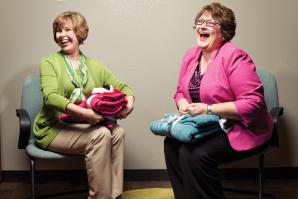In the fall of 2011, the executive directors of the Sacramento Philharmonic and the Sacramento Opera sat in their respective offices staring bleakly at financial reports that were telling each of them what they already knew: Revenues were down, attendance was waning, costs were up. As the two leaders stared at the numbers, the reality of closure stared back.
Roughly 2,000 nonprofits operate in the Capital Region, and hundreds, like Sacramento’s Philharmonic and Opera are seeking to accomplish similar goals through a shrinking pool of grants, contracts and donations. For many of these organizations, consolidation through mergers could be a viable option for streamlining services and maximizing output. It could also mean economic stability for all parties involved.
Merging can be a tricky proposition, but myriad organizations have increased sustainability by identifying other organizations that face similar missions, challenges and opportunities. But there are risks. Personnel may be cut. Boards may be consolidated. Major donors may ask major questions. But the experts say there are ways to mitigate these struggles. They also say that mergers aren’t for everyone; nonprofits on the verge of failure would be wise not to bring down others or rely on another organization for salvation.
In the private sector, mergers and acquisitions are frequent and can make good business sense, but in the nonprofit world, these types of partnerships are rare.
“In the private sector, if the merger or acquisition pencils out, you’re in,” says David La Piana, founder and managing partner for La Piana Consulting, a nonprofit consulting service, and someone who has been involved in more than 100 nonprofit mergers in the past 20 years. “In the nonprofit world, since nobody makes any money through a deal, there is no financial leverage, so that isn’t a motivator.”
According to La Piana, for a nonprofit merger to be successful, the organizations must first review their missions to make sure they closely align. They should also evaluate their individual strengths and weaknesses at the board and staff level and determine whether combining would make both groups stronger.
“Both organizations need to ask themselves, ‘Will doing this strengthen our ability to advance our mission?’ Ultimately, one or both groups will need to relinquish some control, which can be a very tough concept for some,” La Piana says.
In his experience, Jeff Koewler, a partner with Sacramento law firm Downey Brand, has found it rare to have a complete alignment of missions. For example, while two nonprofits might both focus on children’s needs, they might have very different ideas about how to meet them.
And sometimes, two very different nonprofit organizations find their missions overlap. AARP, a social welfare group that advocates for Americans over 50; and Experience Corps, a reading literacy group, were able to successfully join forces in 2012 after they identified intersecting priorities.
AARP was seeking to increase its ability to tap into the experience and dedication of older Americans who want to give back to their communities. Experience Corps had a goal to improve K-3 student literacy in disadvantaged schools through one-on-one tutoring, but to do that, it needed to increase its pool of volunteers. Experience Corps found that seniors make good, reliable reading tutors for children. Combining the two organizations made sense from all angles. To date, the program, now called AARP Experience Corps, has tutors for 27,000 kids and is growing.
“The program is a success on multiple fronts,” says the organization’s managing director, Barbara Quaintance. “Adults who volunteer with this program benefit from improved physical and brain health as well as better social lives. In addition to improved literacy with students, teachers have anecdotally reported they see better attendance and fewer behavior problems when older volunteers are in the classroom.”
But without such alignment, nonprofit mergers face increased risk of failure. The Jewish Museum San Francisco and the Judah L. Magnes Museum in Berkeley, for example, decided to come together in 2002 because both museums needed new buildings. The nonprofits thought it would be economically sound to combine their contemporary and historical collections, though the organizations have very different cultures and missions. The ill-fated merger was short lived, and the two eventually separated.
In 2008, the Jewish Museum San Francisco tried a different approach, changing its name to the Contemporary Jewish Museum and opening in downtown San Francisco in a new building designed by iconic architect Daniel Libeskind. For its part, the Judah L. Magnes Museum looked to UC Berkeley for a second chance, merging with the university in 2010 under the new name Magnes Collection for Jewish Art and Life. It is now permanently situated just off the main campus in its sleek new building and has moved toward a focus on research and education.
Of course, the legalities and logistics of a merger are just the beginning. To grow and thrive, shifts in organizational culture must be met head on.
In June 2010, the Oakland East Bay Symphony merged with the Oakland Symphony Chorus and the Oakland Youth Symphony to become East Bay Performing Arts (EBPA). Under the direction of their newly installed executive director, Steven Payne, the organizations have seen both the upside of the partnership and some real challenges.
Payne faces the critical task of establishing a new culture for the new organization. “We can’t really merge three cultures,” Payne says. “We need to create a new one. As someone new to the organization, I have a great opportunity to do that going forward.” A unified artistic vision is the most important element for Payne, and is at the center of what drives the organization.
“Ultimately, we are in the entertainment business. We need to have fun in our meetings, in our performances,” he says. “People need to choose to be here.”
On the positive side, the merger has enabled the organizations to create administrative efficiencies, artistic synergy and collaboration, according to Payne. To smooth the transition, the EBPA united the three original boards and then cut its size in a two-step process. The boards agreed to a self-imposed two-year timeframe to bring the groups together, which they accomplished, also allowing the organization to find a home for everyone.
But while mergers can be lifesaving, they are not a panacea. Some nonprofits seek a merger when they are in dire straits and are looking for someone to help ensure their viability.
“Sophisticated nonprofits can be reluctant to take on a weak partner,” says Bob Harrington, a partner in La Piana Consulting. “It helps if the organizations engage in exploration before they find themselves in serious financial conditions.”
Still, floundering organizations can merge and stay afloat. To be successful, both nonprofits need to be honest in their self-evaluation and stay true to their mission, plus get buy-in from their boards, the community and their audiences.
In Sacramento, the Sacramento Philharmonic and Sacramento Opera were both hemorrhaging. They were facing significant economic, fundraising and attendance challenges and needed to re-engage the community in a new way. The two organizations had considerable overlap; Michael Morgan was the music director for the Philharmonic and guest conducted for the Opera, and the Opera was using the Philharmonic’s orchestra for its performances.
“They realized they had intersecting challenges and opportunities,” says Harrington, who advised the nonprofits on their 2013 merger.
The boards voted unanimously to merge, and in July 2013, the organizations combined under one umbrella organization known as the Sacramento Region Performing Arts Alliance (SRPAA). The newly formed nonprofit also named a fresh leader, General Director Rob Tannenbaum, and formed one board of directors from the two existing boards. Each organization kept its artistic identity and name.
From the start, SRPAA created some significant and aggressive benchmarks for corporate support, community support and attendance. “The organization decided if the community really wanted to maintain these cultural institutions, they were going to have to step up,” says Harrington. The community accepted the challenge, increasing its financial support and allowing the nonprofits to come up with some imaginative new offerings, resulting in some sold out performances.
“We are the third city in America that has merged their symphony and opera, but are the first city to have successfully merged the audiences,” Tannenbaum says. SRPAA offers patrons the option to buy yearly subscriptions to just the symphony, just the opera or both. Hundreds of audience members have purchased a dual subscription, a testament to the city’s desire to make the merger work and to support both nonprofits.
Going forward, SRPAA’s short-term goals are strictly financial, with Tannenbaum working with patrons, donors and the community to remain financially healthy. Long-term, Tannenbaum plans to soberly and responsibly grow the organization.
“Ultimately, I want to ignite the fire and keep it burning,” he says.
While mergers in the nonprofit arena are less common compared to those in the private sector, organizations that take a strategic, planned approach are being rewarded for their efforts.
“The biggest factor in laying the groundwork for a successful nonprofit merger is to first be sure that both organizations’ causes and missions specifically align and that there is a strategic advantage in pursuing their mission, a special skill or special access with another entity,” Harrington says. “When that happens, the chances of long term success go up exponentially.”
Recommended For You

The Learned Philanthropist
Academic programs for philanthropists and nonprofit leaders are emerging nationwide
After two decades of working in the nonprofit industry, Robin Chronister, an executive assistant for Mother Lode Rehabilitation in Placerville, noticed a gradual but clear change in the nonprofit sector.

Expanding a Vision
New leadership means fresh ideas for Women in Philanthropy
Banning together 12 years ago, a group of local women sought out to help foster youth establish healthy lives after emancipation.



